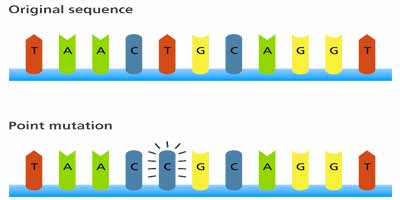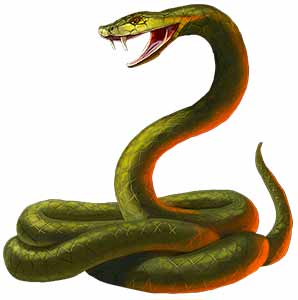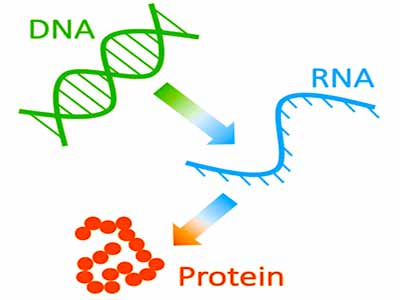
Scientists have discovered many natural mechanisms for the evolution of new genes. Over time biologists have found more and more super obvious evidence for evolution. Many scientists thought evolution was not possible until cells and the genetic code.
The genetic code is very complex. RNA can replicate and evolve given the right circumstances. It can replicate and evolve without needing the genetic code and cell! There’s a separate type of evolution called chemical evolution, which works differently.
How does new genetic information evolve? (Gene Flow Process)
New genetic information can evolve through various mechanisms that introduce changes and modifications to the DNA sequence. Here are some key processes that contribute to the generation of new genetic information:
Mutation: Mutations are spontaneous changes in the DNA sequence that can occur during DNA replication or due to environmental factors such as radiation or chemical exposure. Mutations can alter existing genetic information or introduce new sequences.
Examples of mutations include point mutations (changes in a single nucleotide), insertions, deletions, or chromosomal rearrangements. Mutations are the primary source of genetic diversity and provide the raw material for evolution.
Genetic Recombination: Genetic recombination involves the exchange of genetic material between different DNA molecules, such as homologous chromosomes, during meiosis. This process can shuffle and recombine existing genetic information, creating new combinations of alleles or genes. Recombination can result in offspring with unique genetic sequences that differ from both parents.
Gene Duplication: Gene duplication occurs when a gene copy is accidentally duplicated within the genome. The duplicated gene copy is free to accumulate mutations without affecting the function of the original gene. Over time, the duplicated gene may acquire new functions, resulting in the emergence of new genetic information and novel traits.
Horizontal Gene Transfer: Horizontal gene transfer refers to transferring genetic material between organisms that are not parent and offspring. It can occur through bacterial conjugation, viral transduction, or environmental DNA uptake. Horizontal gene transfer can introduce entirely new genes or genetic elements into an organism’s genome, providing a source of new genetic information.
Epigenetic Modifications: Epigenetic modifications are changes in gene expression patterns that do not involve alterations in the DNA sequence itself. Environmental factors can influence these modifications and can be inherited. Epigenetic changes can affect how genes are turned on or off, leading to phenotypic variations without changes in the underlying DNA sequence.
There are many ways a gene can mutate without changing the structure of the protein. So there are a lot of neutral mutations that can happen in the insulin gene. But if a mutation in insulin occurs, that changes the protein sequence many times. The person born with that mutation ends up having diabetes.
The insulin molecule is remarkably preserved with an amino acid sequence. So protein structure is incredibly preserved across evolutionary time. New genetic information evolves through two primary processes: Point mutation and Gene duplication.
Point mutations
The genetic information within a stretch of DNA or RNA is called a gene. It helps determine the size, shape, and even the behavior of a living creature. Humans have over 20,000 genes that tell cells how to build and maintain bodies. The information needed to create a person differs from the information needed to create a mushroom. Biologists, however, say that all living things on Earth, including:
- People and mushrooms evolved from an ancient common ancestor.
- A relatively simple creature with far less genetic information than the plants, animals, and fungi are alive today.
If this is true, how did all this new genetic information evolve? Scientists don’t yet know how the first genes came about. But through careful genetic studies of living things in the wild in the laboratory and backyards. They have discovered many ways in which new genetic information evolves today.
Point mutation is any change that only affects a single pair of nucleotides or letters in the genetic code. They often occur when cells are reproducing, and they appear to be mostly random. They’re surprisingly common.
Current studies suggest that every child born has roughly 70 unique point mutations in humans. Most mutations are completely neutral. One lands in a sensitive spot of genetic code, often negatively affecting a creature’s survival and reproduction ability.
Natural selection usually takes care of these negative mutations by removing them from the Gene pool. On rare occasions, beneficial point mutations occur. During the changes, they aren’t quite as extreme. Incredible changes have been observed.

Researchers in the Lab of Dr. Richard Lenski have observed and documented hundreds of mutations in Bacteria. One of these, for example, was a beneficial point mutation found in a strain of E.coli. An ‘A’ from its code was replaced with a ‘T’ code. Those who carried the mutation could reproduce faster than normal in the lab. They outcompeted in less than one year and caused the complete local annihilation of their non-mutant siblings.
In 1976, two scientists reported a strange mutation in salmonella in one of their labs. Their work was recently evaluated by Dr. Michael Behe, who classified their discovery as a rare gain of function mutation. The mutation allowed these microbes to detect and eat a rare sugar called ‘D’ arabinose. Microorganisms are interesting, but what about larger, more complex animals? Can simple mutations give them new features?
Most domestic dogs and their wild relatives, gray wolves, have short fur. Some dog breeds, however, have extremely long fur. Comparing their DNA to wolves, scientists discovered a single-point mutation in a gene called FGF5. This point mutation that changed ‘G’ to ‘T’ is largely responsible for the long fur—dozens of dog breeds, including the Shih Tzu, Collie, and the Pomeranian.
What about wild plants and animals? Can they undergo positive point mutations as well? Cane toads and their relatives produce a milky toxin and a gland behind their ears. That kills almost any animal that tries to eat them. They have tiny protein structures like pumps embedded in the cell’s Membrane or skin. This protein pumps electrolytes in and out of the cell. Toad toxins work by attaching to and clogging these pumps, wreaking Havoc throughout a creature’s body.
Dr. Nicholas Casewell and his colleagues recently found that several different animals, lizards, snakes, and hedgehogs, have all independently undergone small point mutations. They modify the shape and stickiness of their transporter proteins. As a result, toad toxins fail to attach, meaning these mutants are now immune to the poison.
So to sum things up, point mutations are an excellent source of new genetic information for a population. Point mutations do not usually increase the total information in an individual’s genetic code. Instead, they edit what’s already there, meaning [that] for the individual, old information is lost when new information is gained.
Gene duplications
A duplication event followed by further mutations is one of the most common and well-understood pathways. A duplication event is a type of mutation where a stretch of genetic code is duplicated and reinserted into a creature’s DNA. Duplications happen naturally all the time. They can be small, a few letters, or long nucleotides. Other times entire genes can be duplicated, dramatically increasing the length of a creature’s genetic code.
During duplications and in the following generations, further mutations in the new gene give rise to entirely new genetic information. That codes for new proteins with new functions. Scientists have directly observed duplication events in the lab many times over. It is because they can now examine the genetic code of any living creature, look for known signatures of past duplication events, and begin to piece together an understanding of how specific genes likely evolved.
Here are three traits that arose from gene duplications:
- The dachshunds have odd-shaped yet powerful legs.
- The unique digestive enzymes of leaf-eating monkeys.
- The evolution of snake venom.
Dachshund’s short legs look simply like a disability! On the contrary, the unique shape of this dog’s legs makes it a surprisingly powerful digger. Most importantly, it can enter small burrows to coax out rabbits, groundhogs, and even Badgers from their dens. Other dogs can only dream of such adventures. Researchers have found their unique legs result from a duplication event by looking at the dachshund’s DNA! A gene called FGF4 was copied and inserted elsewhere in their DNA.

The new gene produces the protein in a way that interacts with their growing bones, reshaping the dog’s legs and opening up an entirely new hunting niche for the animal. Humans who liked the trait bred the original dog with many others, eventually leading to several new dog breeds and proving that sometimes. Even the strongest of mutations within the right environment turns out to be highly beneficial!
Now let’s look at the fascinating case of the leaf-eating monkey from Vietnam: the Duke langur. Several species of Asian monkeys eat almost nothing but leaves. That would cause humans and most other primates major stomach problems.
The monkeys achieve this fantastic feat of digestion with the help of several adaptations. One of which was first made possible by gene duplication. RNASE1 is a protein found throughout cells and blood. Experiments have shown that this protein helps our cells fight against viruses by attaching to and breaking down virus genes.
RNASE1 does a similar task in the intestines but for different purposes. It breaks down genes from the food cells, converting them into nutrients the body can absorb. In humans, the pH or acid levels of the intestines are pretty much the same as the pH levels of cells. It allows a single version of RNASE1 to work significantly, fighting viruses in the body and digesting food inside the intestines.
In leaf-eating monkeys, however, the intestines are more acidic. This acid appears to help break down the rigid cell walls of raw leaves. But unfortunately, the extra acid also slows down RNASE1 proteins, which are extremely sensitive to acid.

Scientists have found that a relatively recent duplication in the monkey’s RNASE1 gene has fixed this problem. The original gene still makes normal proteins to help fight against infections. Still, after being duplicated, the new gene began accumulating mutations that slowly made it better and better at functioning in acid. A clear case of a single gene once at two different jobs was duplicated. The two genes have since specialized in producing proteins for different tasks.
Now for an exciting yet slightly disturbing example: The evolution of snake venom! Genes inside the saliva glands of most creatures, humans included, produce particular proteins. They can start breaking down food chemically, even before it gets to the stomach.
Venomous snakes, however, have taken this a step further. Their saliva glands produce venom! A cocktail of proteins and other molecules that kill their prey when injected. Let’s see how one of these toxic proteins evolved.

Many assume blood clots form when cuts dry in the open air. Amazingly Clots form through a series of chemical reactions that can quickly seal the wound, even underwater. This ability is possible partly because of a protein called Factor X. It’s found in the blood of many animals, including fish, frogs, snakes, birds, and even people.
- Factor X is typically dormant or sleeping, drifting about the bloodstream with no effect.
However, when a blood vessel is cut, chemicals in the damaged tissue activate factor X at the injury scene. Factor X then initiates a series of chemical reactions, causing a clot to form to seal the wound. The saliva of the Australian rough-scaled snake is loaded with preactivated factor 10 proteins!
If the snake bites an animal, injecting its saliva directly into the wound, rapid clotting occurs throughout the victim’s body. The result is often death! When scientists look at the genes that code for this protein. They see clear signs that the snake’s very own factor X gene, which it uses in its blood, was copied through a duplication event.
After or during duplication, mutations in and near the new gene cause it to produce factor X protein in the venom glands instead of the blood. As time passed, small mutations built up in the duplicated gene, making it more and more efficient.
So to sum things up – how is it that new genes evolve? One of the most essential and well-understood pathways is for genes to duplicate and accumulate new mutations. Gene duplications and similar mutations like insertions, deletions, and point mutations occur naturally throughout the living world. These mutations are constantly occurring and are constantly filtered through natural selection. There are no limits to the variety of new genetic information, new traits, and new species that evolution can produce!
The flow of genetic information
DNA is a double-stranded molecule, and it’s called the double helix. It makes a helical shape, which involves bonding and twisting the helix. DNA consists of monomers: nucleotides and nucleotides are composed of nitrogenous bases such as adenine, guanine, cytosine, and thymine. Then it’s also made up of five-carbon sugar deoxyribose. It has a phosphate group on the very outside.

So there’s a couple of things happening here. DNA replication occurs during binary fission in bacteria or mitosis and meiosis in eukaryotic cells, depending on the cell type. In DNA replication, duplicate copies of the DNA are passed down to the daughter cell. Meiosis is a bit of a variation on that. So the idea is to make copies that would then be passed down to prokaryotic or eukaryotic cells. That’s one flow. The main flow in the cell itself that’s going on on an ongoing basis is the process of transcription and translation.
Transcription is taking the genetic information in DNA and putting it into a moveable molecule, the mRNA. It is m or messenger RNA that carries the messages. In eukaryotes, this will leave the nucleus and go out into the cytoplasm, and prokaryotes such as bacteria are contained. So it’s happening altogether within the cytoplasm.
The final step occurs at the ribosome, which is valid for prokaryotic or eukaryotic cell types. The messenger RNA goes to read at the ribosome and translate. As the mRNA moves through the ribosome, there’s another type of molecule called tRNA, and it’s also single-stranded, like the messenger RNA. The tRNA stands for transfer RNA. It reads the AUC and G sequence on the mRNA, bringing over the appropriate amino acid.
So at the ribosome, it is slowly building an amino acid chain. Ultimately, that amino acid chain gets folded into a functional protein. So proteins have secondary, tertiary, and quaternary structures related to that three-dimensional folding. It’s not a single linear chain. It’s folded into specific shapes.
More Articles:
What About Evolutionary Fitness?
How does Evolution Process work?
Why Are People Right Or Left-Handed By Evolution?
How Did Blood Evolve By Earth Timeline?
What Is Founder Effect In Genetic Drift?
References:
Griffiths AJ, Miller JH, Suzuki DT, Lewontin RC, Gelbart, “Genetics and the Organism: Introduction.” An Introduction to Genetic Analysis (7th ed.). New York: W.H. Freeman. ISBN 978-0-7167-3520-5.
Weiling F., “Historical study: Johann Gregor Mendel 1822–1884”. American Journal of Medical Genetics.
Richmond ML, “Opportunities for women in early genetics.” Nature Reviews Genetics.
Table of Contents
